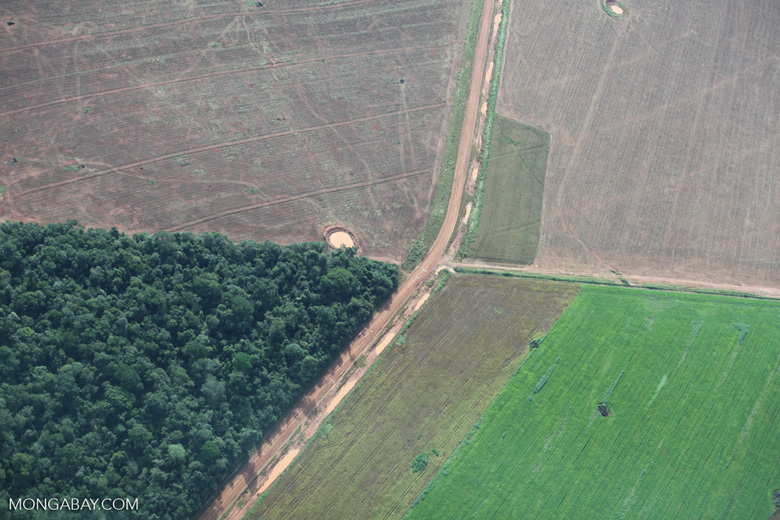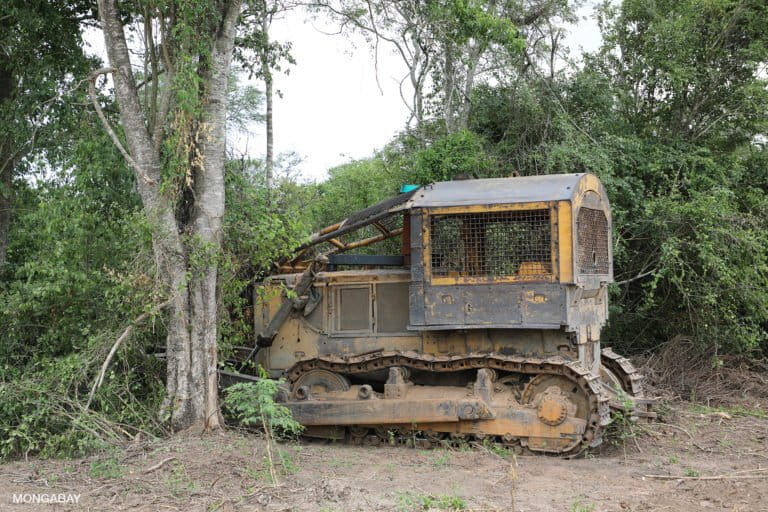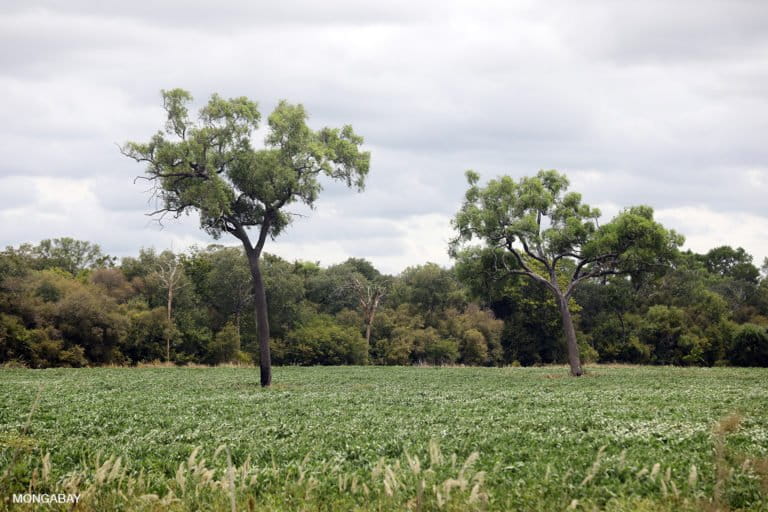- The Brazilian Cerrado once covered two million square kilometers (772,204 square miles), an area bigger than Great Britain, France and Germany combined, to the east and south of the Amazon. But today, more than half its native vegetation is gone largely due to a boom in soy production – with the valuable beans exported to the EU and other nations.
- The Amazon Soy Moratorium, a voluntary agreement, while reducing soy-caused deforestation In the Amazon biome, resulted in intensified deforestation in the neighboring Cerrado savannah biome. And until recently, transnational commodities firms have resisted a similar deforestation agreement in the Cerrado.
- Now 6 commodities companies and members of the Soft Commodities Forum – Cargill, Bunge, Louis Dreyfus Company (LDC), Archer Daniels Midland (ADM), Glencore Agriculture, and COFCO International, a Chinese firm – have announced a new agreement to monitor soy supply chains in 25 Cerrado deforestation “high risk” municipalities.
- This new voluntary industry agreement, while a step forward, is seen as partial by critics. They say that more measures are needed to achieve zero forestation, stop farmworker exploitation, conserve land and water, and reduce over-usage of toxic pesticides.

In a step toward limiting the loss of Cerrado biome native vegetation, six major commodity traders have agreed on a common framework for monitoring soy supply chains in 25 deforestation “high risk” municipalities within the vast savannah – currently a hotspot for Brazilian deforestation.
Members of the Soft Commodities Forum (SCF) – a global platform of leading commodity companies including Cargill, Bunge, Louis Dreyfus Company (LDC), Archer Daniels Midland (ADM), Glencore Agriculture, and COFCO International, a Chinese firm – have agreed to monitor and publish data concerning trading company soy supply chains from those Cerrado municipalities facing the “highest risk of conversion of native vegetation to soy,” according to an SCF statement. The Soft Commodities Forum is a subset of the World Business Council for Sustainable Development (WBCSD).
The definition of what exactly “high risk” means, will be determined by the Cerrado Working Group (GTC), an entity comprised of the commodities industry, NGOs, producer organizations, Brazilian consumer goods companies, financial institutions and the government.
“Sourcing in these municipalities will be reported in percentages of direct purchase from farmers, and indirect purchase from parties like aggregators, cooperatives and third parties,” a Cargill representative, told Mongabay. The first report by the SCF partnership will be published in June.

To start, the six companies are committed to monitoring supply chains in 25 Cerrado municipalities, says David Cleary, director of global agriculture at The Nature Conservancy (TNC), an NGO. TNC works with soy traders, helping them implement their deforestation commitments. The agreement is important, says Cleary, not least because it came through the SCF, which involves six major traders. “They have a significant weight on the market, it means a lot that they did this together, rather than on an individual basis,” he says.
“The Soft Commodities Forum facilitates the first time leading global commodity traders are working together in a pre-competitive project to address sustainability risks they all share, but which no single company can resolve alone,” says Diane Holdorf, managing director for Food & Nature at WBCSD.
However, many industry analyists, though pleased by this seeming progress, are reserving judgement on the agreement’s significance. It is too early to assess the announced measures properly, with much depending on the definition used to select “high risk” municipalities, explained Tiago Reis, a PhD researcher on agricultural supply chains at Université Catholique de Louvain: “The devil is in the details. But it looks like a step forward,” he said.

A biome in serious trouble
The Brazilian Cerrado once covered two million square kilometers (772,204 square miles), an area bigger than Great Britain, France and Germany combined, stretching to the east and south of the Amazon. But today, more than half its native vegetation is gone.
The main driver of this destruction is the flourishing soy industry. The high demand by the European Union and other nations for the valuable bean has directly and indirectly led many producers to convert the Cerrado’s biodiversity-rich dry forests and bushland into vast soy plantations, sometimes crossing legal boundaries to do so. In recent months, the demand for Brazilian soy continued rising further, partly the result of the lingering US-China trade war.
Conservation NGOs and scientists have been lobbying for a more comprehensive protection of the Cerrado for years now, and demanded a similar framework to the 2006 Soy Moratorium in the Amazon – a voluntary agreement by which transnational commodities companies such as Bunge, ADM, Cargill, and Amaggi, along with other actors, agreed not to source soy from newly deforested areas within Legal Amazonia.
Studies suggest that the Amazon Soy Moratorium has been successful in keeping Amazon deforestation rates low, with the expansion of agriculture slowing down significantly following a peak in 2004. However, in contrast to the Amazon, where the moratorium was in place, conversion rates from native vegetation into pastures and soy plantations has increased dramatically in the so-called Matopiba region – a large section of the Cerrado biome comprised of Maranhão, Tocantins, Piauí, and Bahia states and an area characterized by extensive agricultural development.
One recent study, in fact, suggests that the Amazon Soy Moratorium was partly to blame for the surge in soy production in the neighboring Cerado. Vivana Zalles, doctoral candidate at the Global Land Analysis and Discovery (GLAD) lab, has studied the “leakage” of deforestation from the Amazon to the less well protected Cerrado, a phenomena undervalued for a long time.
Also undervalued until recently was the Cerrado’s carbon storage capacity. That’s because the savannah biome lacks the vast aboveground rainforests of the Amazon. Instead its plants grow largely downward into unseen but extensive root systems, “a forest upside down” that functions as an important carbon sink and curb against climate change. Further, the biome is home to more than 10,000 plant species, over 900 birds and 300 mammal species, all increasingly threatened if deforestation should continue at the present speed.

East-West commodities firm alliance
The new soy supply chain monitoring agreement is especially significant not only for what it could do, but because of one of its traders – COFCO International, a Chinese firm. Company CEO, Jun Lyu stressed the importance of fighting deforestation in Davos last year, and specifically talked about Cerrado conservation at the January 2019 conference.
After those tantalizing public statements, environmentalists waited for actual commitments, which have now arrived with the SCF agreement: “It’s an historic development, as it’s the first time that a Chinese trader is coordinating with Western companies to promote sustainability,” Cleary states. This is especially key given China’s powerful and rapidly growing influence on the Brazilian agribusiness market.
The agreement comes at a critical time, says Cleary, who points to current political developments in Brazil. During the last three months of the 2018 presidential election campaign, Amazon deforestation rates soared by nearly 50 percent, possibly as ruralistas – rural landowners and agricultural producers – anticipated policy changes under the presidency of rightist Jair Bolsonaro, who strongly favors agribusiness profits over environmental protections.
With this new agreement, “Soy companies are sending a signal to Brazil” and its new government, says TNC’s Cleary. The commodities firms “are working in an [international] market where sustainability concerns are important, so they show with this measure where the market is going.”

Deforestation financial incentives needed
Cleary and others agree that it will likely be difficult to make a zero-deforestation commitment attractive to producers. That’s because achieving such a goal, in many cases, could require farmers to make greater deforestation commitments than those required by Brazil’s forest protection laws, which in turn might mean smaller profits.
He says that in order to remedy this dilemma, traders are going to use the carrot not the stick, working closely with financial institutions to develop deforestation financial incentives for farmers. While current contracts are commonly signed from one harvest to the next, credit lines could become longer in the future, a benefit which farmers would appreciate.
“We will see a lot of experiments with different measures in the next year. Traders will want to talk to banks and financial institutions to attract farmers to zero-conversion commitments,” says TNC’s Cleary. However, whether this will actually translate into less deforestation depends a lot on market developments.
Fábio Pitta from the NGO Rede Social de Justiça e Direitos is sceptical, and has strong doubts as to the financial viability of zero deforestation. “Brazil is in [an economic] crisis right now and [the government is] weakening all kinds of protection laws to increase the profits of [agribusiness] enterprises,” he says, adding that deforestation and agricultural expansion are driven by the need to increase production in hard economic times, largely in order to be able to pay off debts.
The new agreement and the incentives “are an important step, but difficult to trust,” Pitta concludes.

The key to protecting forests within commodity supply chains lies in transparency, says Reis. He calls the SCF announcement a cautious move, and urges a bolder initiative that would establish a non-secret paradigm for business information throughout the Cerrado and elsewhere. For the scientific community, the full disclosure of producer-commodity company purchasing data would offer a new possibility for analyzing and understanding the vulnerability of traders to deforestation.
Until now, one of the most useful data sets to work with is the platform Trase, Reis says, a data base which allows interested parties to follow trade flow to identify sourcing regions, profile supply chain risks to the environment (such as deforestation), and to assess opportunities for sustainable production. TRASE is an initiative of the Stockholm Environment Institute and Global Canopy, two international NGOs.
However, Trase, lacks pinpoint accuracy in some parts of the supply chain because it is built with the help of modelled projections because traders won’t disclose municipal level procurement data. “Trading companies protect their [producer] purchasing data all around the world and say it’s part of their [proprietary] core business,” says Reis. “All companies would have to disclose the information together to avoid [competitive] disadvantages. We need a bold industry move” to bring about that sort of wide ranging cooperation.
The new SCF reporting measures in the Cerrado could be a kick-starter for just such a trend, say some experts.
Isolete Wichinieski from Comissão Pastoral da Terra (CPT), a Catholic Church organization, warns that Cerrado conservation can’t only focus on “high risk” municipalities; it will demand many regionwide socio-environmental commitments. That’s why she is coordinating the Campaign in Defense of the Cerrado: “Barring deforestation is important, but measures are also needed to stop the exploitation of workers, land and water, as well as the usage of huge amounts of agrochemicals,” Wichinieski says.
To develop and implement those sorts of sweeping strategies one can’t only rely on industry, she concludes. It will also call for the inclusion of the Cerrado’s traditional communities, who have protected the savannah and lived sustainably within the biome for more than a century.
Banner image: A soy field, with forest in the distance. Image by Rhett A. Butler / Mongabay.
FEEDBACK: Use this form to send a message to the author of this post. If you want to post a public comment, you can do that at the bottom of the page.

